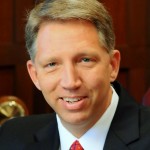A President Changes Leadership Roles
By Emily Rogan
May 12, 2015
In September, Scott Ralls, North Carolina’s Community College System president, will take the helm at Northern Virginia Community College. In this Q&A, he reflects on the work he accomplished in North Carolina.
 Scott Ralls became the seventh president of North Carolina’s Community College System in 2008, just as the economy was tanking and educational institutions were facing fiscal crises like never before. Yet under his leadership, the system grew 28 percent between 2007 and 2010 and experienced profound improvements in areas such as remedial education, completion rates and transfer articulation agreements. Ralls will become president of Northern Virginia Community College (NOVA) in September, returning to his roots as the president of a college rather than a state system. On the eve of his departure, he shares some thoughts with the 21st-Century Center.
Scott Ralls became the seventh president of North Carolina’s Community College System in 2008, just as the economy was tanking and educational institutions were facing fiscal crises like never before. Yet under his leadership, the system grew 28 percent between 2007 and 2010 and experienced profound improvements in areas such as remedial education, completion rates and transfer articulation agreements. Ralls will become president of Northern Virginia Community College (NOVA) in September, returning to his roots as the president of a college rather than a state system. On the eve of his departure, he shares some thoughts with the 21st-Century Center.
How do you feel about your new position?
I’m excited about the opportunity. NOVA is one of the largest community colleges in the United States. I’ve always admired their focus on student success and technology-focused workforce development; I fit into the culture and commitments that are already there. And I’ve always aspired to go back to campus; for people who know me, this doesn’t come as a surprise.
Is it bittersweet?
It is. I love the North Carolina Community College System. I’m from here, and I grew up here. Having put so much into the North Carolina system, it will always be a part of me. But there are more similarities than differences between the two; NOVA is almost like a cousin in some ways.
When you’re involved in community college education, if it’s really what you believe in, it’s tough to leave. It’s why I need to go back to campus. I need to be a little closer to students and faculty.
What was your proudest achievement?
I am proud of the things we did collectively in North Carolina during that time period. The recession in spring 2008 hit North Carolina very hard and created extraordinary challenges. It showed great leadership throughout the system that we further helped our students and our communities. There were big changes to developmental education, redesign of dual enrollment and statewide strengthening of technical and math education. There was collaborative work with public and private colleges to redesign our articulation agreements to strengthen pathways for student enrollment. Our colleges and leaders weren’t defined by our challenges but by our opportunities.
Looking back, would you have done anything differently?
There were things I would have done differently, but I don’t know that they would have gone any better. It was a collaborative experiment; the way our system works we collectively took on challenges. I’m proud of the faculty leaders who came up with solutions. For example, over 600 faculty members spent hours to redesign the math curriculum. It was really courageous — get them in a room and they can accomplish just about anything.
What have you learned?
I learned how much faculty members care about what they do and how insightful they are to come up with new ideas.
You have to be willing to face up to some of the biggest challenges. We made ourselves an open book when it came to data or analyses that suggested to us that we weren’t doing as well as we thought. You can’t just use anecdote but be open to data-driven discussions that may lead you to a different place.
You have to be careful not to put too much pressure on yourself. There is a perception that as a president, you’re supposed to have all the answers and provide this vision that you carry around. You shouldn’t be the one to come up with all of that. If you do your job right, you surround yourself with people a lot smarter than you. You make sure people are working collectively toward common objectives and not assuming that you have all the answers.
If you could wave your magic wand, what would you do?
My mentor Bill Friday once said community colleges are the great contribution America made to worldwide education; they are uniquely American. No institution has more potential than community college to make the notion of the American dream — that one can aspire to a better tomorrow than today — a reality for low-income and underserved students.
I wish more people outside the community college world really understood that — that they really valued community college as much as the people who see it firsthand.














